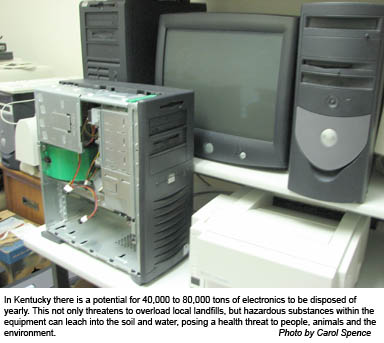E-Scrap a Mounting Problem … With Solutions
E-Scrap a Mounting Problem … With Solutions

It wasn’t that long ago when the only technical gadgets a typical family had were a television set, a stereo and a phone. And they held on to those few things for years and years. Not anymore. Now add to the list multiple televisions, a cell phone for everyone in the house, an MP3 player or two, desktop computers, laptop computers, video games, DVD players, batteries of every shape and size…. The list goes on and on. And when the products break or get replaced with newer versions, where does it all end up? With a little foresight and planning, the answer doesn’t have to be the local landfill.
Ashley Osborne, University of Kentucky Cooperative Extension associate for environmental and natural resource issues, is a proponent of finding alternative solutions to the mounting problem of the 40,000 to 80,000 tons of electronics that could potentially be disposed of yearly in Kentucky. It’s not merely the amount of e-scrap, as it is called, that can cause a serious problem by overloading local landfills. The hazardous substances within the equipment can pose a health threat to both humans and the environment.
“For example, the glass picture tubes found in computer monitors and television screens contain between 5 and 8 pounds of lead,” Osborne said. “Other hazardous materials found in electronics include chromium, cadmium, mercury and nickel.”
Under certain conditions, these substances can dissolve and leak into the groundwater. Once in the groundwater, they can spread throughout an entire watershed, possibly contaminating drinking water and getting into the food supply. All of them can present serious health risks to people.
The U.S. Government Accountability Office, in a November 2005 report, estimated that more than 100 million computers, monitors and televisions become obsolete each year and that the number will continue to grow, particularly with a rise in the number of plasma televisions replacing older technology. The U.S. Environmental Protection Agency’s Web site indicates that electronics make up from 1 to 4 percent of solid waste at the municipal level and that the amount of e-scrap is growing three times faster than other forms of solid waste.
With America Recycles Day just around the corner on Nov. 15, making arrangements to safely dispose of discarded electronics is an important step toward making sure the environment is safe for future generations.
Osborne said there are a number of options available to people who want to dispose of older or broken equipment. Her first suggestion is to simply fix or upgrade existing electronics. In that case, disposal is no longer an issue, because the equipment continues to be used.
If the equipment is still in good working order, another option is to donate it to a school, church or charitable organization and receive a tax deduction in return. If you are unsure which organization can make use of the equipment, Osborne said that there are a number of Web sites that can steer you in the right direction, one of which ishttp://www.collectivegood.com. The site lists charitable organizations that will accept mobile phones, pagers or personal digital assistants. The e-cycling page on the EPA Web site, http://www.epa.gov, also offers links and suggestions for organizations that will accept used electronic equipment donations.
If neither of these solutions is practical because of the age or condition of the equipment, many municipalities offer local recycling programs.
“Each county has a solid waste coordinator,” said Osborne. “That would the person to contact to find out how to dispose of hazardous waste and e-scrap safely in your area.”
The Web site http://www.earth911.org provides information about local waste management regulations and area options for recycling electronics and batteries when a user types in a zip code. Some of those local sites will also provide the names of organizations accepting equipment donations. A Kentucky government Web site,http://www.waste.ky.gov /programs/rla, also lists electronics recycling opportunities.
“By being a responsible citizen and reusing or recycling electronics, you not only are reducing the amount of waste that goes to landfills, but you also are conserving other resources needed to manufacture new computers, televisions, and cell phones,” Osborne said. “Also by donating old electronics you may be helping someone who cannot afford to purchase these things new.”
